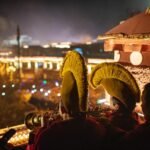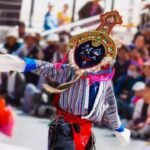Unveiling the Significance of Tibetan New Year (Losar)
Tibetan New Year, known as Losar, stands as the paramount festival in Tibet, marking the commencement of a new year in the Tibetan calendar. Let’s delve into the essence of this cherished celebration, rich in cultural heritage and tradition. Losar unfolds on the 1st Month of the Tibetan calendar, commencing from the 29th day of the twelfth month, extending joyously over a span of approximately two weeks. It echoes the vibrancy of Tibetan culture and tradition.
Cultural Harmony: Diverse Celebrations
Rooted in Tibetan astrology and lunar calendars, Losar coincides closely with the Chinese Spring Festival and the Mongolian New Year, reflecting the cultural interconnectedness of the region. Beyond Tibet, Losar finds resonance in Bhutan and Mongolia, transcending geographical boundaries. Across Tibet, Losar is celebrated in diverse ways, with each region showcasing its unique customs and traditions. However, the festivities in Lhasa stand out as the epitome of Losar celebrations, offering a glimpse into the heart of Tibetan culture.
Blend of Traditions
While Losar Rituals incorporate numerous Buddhist elements, the festival maintains its secular essence, characterized by its distinctive flavor. It serves as a testament to the harmonious coexistence of spirituality and tradition in Tibetan culture. Experience the enchantment of Losar, a festival that embodies the spirit of renewal and unity, transcending differences and fostering cultural solidarity among communities across Tibet and beyond.

Tracing the Origins of Losar: A Journey Through Time
The history of Losar, the Tibetan New Year celebration, is steeped in ancient traditions that predate Buddhism in Tibet. Let’s embark on a journey to uncover the roots of this revered festival and its evolution over the centuries.
Pre-Buddhist Origins
Losar traces its origins back to the pre-Buddhist Bön period, where it served as a spiritual ceremony to honor local spirits, deities, and protectors. During this time, people offered incense in abundance to appease these spiritual entities, laying the foundation for what would later become the Losar festival.
Evolution into a Buddhist Festival
Over time, the religious festival evolved into an annual Buddhist celebration, believed to have originated during the reign of Pude Gungyal, the ninth King of Tibet. The introduction of time measurement based on lunar phases by an elderly woman named Belma marked the inception of Losar as a significant cultural event.
The timing of the Tibetan New Year coincided with the flowering of apricot trees in regions such as Lhokha Yarla Shampo and Kongpo/Nyingtri, symbolizing the onset of the traditional farmers’ festival. This period also witnessed the introduction of agricultural practices and technological advancements in Tibet, laying the groundwork for the Losar festivities.
Emergence of Losar
With the introduction of rudimentary astrology based on the five elements, the farmers’ festival transformed into what is now known as Losar or the New Year’s festival. The term “Bo Gyal Lo,” meaning “Tibetan King’s Year,” reflects the festival’s association with the enthronement celebration of the first Tibetan King.
Losar spans 15 days, with the main celebrations concentrated on the first three days. On the inaugural day, Changkol, a beverage derived from Chhaang, is prepared. The second day, known as King’s Losar, holds special significance, preceded by a five-day practice of Vajrakilaya.
Cultural Synchronicity
Although Losar coincides with the Chinese and Mongolian New Year due to calendar adaptations, its traditions and customs remain uniquely Tibetan. Originally celebrated on the winter solstice, the festival’s alignment with neighboring New Year celebrations was orchestrated by a leader of the Gelug school of Buddhism. Experience the richness of Losar, a festival that bridges the past with the present, embodying the spirit of cultural resilience and unity in the vibrant tapestry of Tibetan heritage.

Diversity of Losar Celebrations: Exploring Regional Variations
While Losar holds a central place in Tibetan culture, its celebration manifests uniquely across different regions and communities, each adding its own flavor to this vibrant festival. Let’s delve into the diverse tapestry of Losar traditions around the world.
Regional Celebrations
Beyond Tibet, Losar is embraced by various ethnic groups including Yolmo, Sherpa, Tamang, Gurung, and Bhutia, each with their distinct New Year customs. These communities, while celebrating Losar, also honor their own regional new year traditions, enriching the cultural mosaic of the festivities.
Seasonal Diversity
Losar unfolds in different months across various regions, reflecting the diverse agricultural and lunar calendars prevalent in these areas. Tsang Losar and Kongpo Losar, celebrated in the 12th month of the lunar calendar, exemplify the agricultural Losar festivities, each imbued with its unique customs and rituals.
King Losar: A Time-Honored Tradition
Among the myriad of Losar celebrations, King Losar stands out as the most renowned, observed with great fervor throughout Tibet. This grand festival epitomizes the essence of Losar, bringing communities together in joyous celebration and reflection.
Colorful Festivities
Losar festivities are marked by a kaleidoscope of vibrant activities, offering a glimpse into the rich cultural heritage of Tibet and its neighboring regions. Families reunite, dressed in their finest attire, to partake in traditional rituals and customs that have been passed down through generations.
Traditional Activities
From exhilarating horse racing to spirited folk dancing and singing, Losar celebrations abound with cultural performances that showcase the vitality of Tibetan traditions. Additionally, religious activities play a significant role, offering moments of spiritual reverence amidst the jubilant festivities. Experience the diversity and richness of Losar, a festival that transcends geographical boundaries, uniting communities in a tapestry of cultural celebration and solidarity across the globe.
Experiencing Losar in Lhasa: A Spiritual Journey
Lhasa emerges as the quintessential destination to immerse oneself in the vibrant festivities of Losar, offering a glimpse into the heart and soul of Tibetan culture. Let’s explore the enchanting rituals and joyous gatherings that define Losar in the capital city.
Spiritual Reverence at Sacred Temples
Losar in Lhasa is synonymous with devout pilgrimages to revered temples such as Jokhang, Drepung, Sera, and Nechung. Here, pilgrims converge to offer incense and butter lamp offerings, seeking blessings for auspicious beginnings. The streets come alive with the resplendent sight of Tibetans adorned in traditional attire, adding a colorful touch to the spiritual ambiance.
Cultivating Positive Beginnings
Embedded in Buddhist philosophy, Losar rituals emphasize the cultivation of a positive mindset to lay the foundation for a prosperous new year. Tibetans engage in virtuous actions and auspicious acts during the initial days of the year, symbolizing the establishment of favorable conditions for the journey ahead.
Purification and Renewal
In the days leading up to Losar, communities unite in a collective effort to pacify negativity lingering from the previous year. Monasteries and temples orchestrate elaborate rituals aimed at expelling negative influences, ensuring a fresh start for the New Year. The mesmerizing lama dances, steeped in tradition, captivate observers with their spiritual significance and rhythmic grace.
Preparations for New Beginnings
As Losar approaches, households buzz with activity as families embark on preparations for the festive occasion. Cleaning rituals and the creation of new clothes symbolize a renewal of spirit and a fresh start. Each home becomes a sanctuary of anticipation, echoing with the joyful anticipation of the dawn of a new year.
Experience the magic of Losar in Lhasa, where tradition and spirituality converge to usher in a celebration of renewal, community, and boundless hope for the future. Join the vibrant tapestry of festivities as Lhasa comes alive with the spirit of Losar, inviting all to partake in its timeless allure.
Celebrating Losar: A Time of Joy and Tradition
Day 1: Dawn of New Beginnings
Losar commences with the break of dawn as families and communities gather in temples alongside monks and lamas. Dressed in fresh attire, reminiscent of renewal, participants join in making heartfelt wishes for the year ahead. Amidst the serene ambiance of the temples, prayers echo, marking the auspicious onset of the New Year. Following the morning rituals, the day unfolds with leisure and merriment, offering an opportunity for relaxation and enjoyment.
Day 2: Bonding and Festivities
The second day of Losar heralds joyous reunions as Tibetans visit one another, embracing the spirit of togetherness. Families and friends come together to indulge in the pleasures of good food, laughter, and camaraderie. Stories are shared, games are played, and the air reverberates with the laughter of children as they delight in setting off fireworks. It’s a day dedicated to fostering connections and creating cherished memories.
Day 3: Communal Offerings and Spiritual Reverence
On the third day, the community congregates atop buildings or hills for a grand communal offering. Adorned in their finest attire, participants gather around the Stupa, a symbol of spiritual reverence. The ceremony commences with the ritual of lhasang, an offering of fragrant smoke to appease divine and celestial beings. Led by lamas and monks, the gathering culminates in a collective chant and the symbolic hurling of roasted barley flour, known as tsampa, into the air as an offering of prosperity and well-being. This practice embodies the essence of ‘raising wind horse’, uplifting the human spirit and ushering in favorable circumstances for all.
As Losar unfolds, amidst the flurry of festivities and cultural traditions, remember to greet fellow celebrants with the warm salutation of ‘Tashi Delek’, encapsulating the spirit of good wishes and blessings.
Whether observed over three days or extended across two weeks, Losar embodies the essence of renewal, community, and spiritual growth, weaving a tapestry of joy and tradition that resonates throughout the Tibetan culture.
Preparing “Chayma” and “Kasai” for Prosperity
Before the Tibetan New Year, households engage in meaningful preparations, symbolizing hopes for abundance and prosperity in the upcoming year. They craft or purchase “Chayma,” wooden measures for grain, embodying the aspiration for bountiful harvests. Alongside “Chayma,” they prepare “Kasai,” fried twisted dough sticks, renowned for their golden hue and crispy texture, representing prosperity and good fortune. Additionally, they fashion “luoguo,” butter-shaped delicacies resembling sheep heads, symbolizing the thriving of domestic animals and a life of plenty. Offerings of dried or fresh fruits, butter, and brick tea are presented to the Buddhas, enriching the spiritual significance of the occasion.
Embracing Family Reunion and Rituals
As the Tibetan New Year approaches, families unite in joyous anticipation, marking the occasion with cherished traditions and rituals.
December 28~29: Cleansing and Auspicious Beginnings
Families embark on a collective endeavor to cleanse their homes, adorning the center of the kitchen wall with “eight auspicious paintings.” Symbolizing auspiciousness and prosperity, lime is meticulously sprayed in front of houses, forming intricate designs. New Year’s Eve also coincides with the Ghost Exorcising Festival, where familial bonds are strengthened over a hearty dinner. A highlight of the evening is the consumption of Guthuk, a savory dish comprising beef, mutton, turnip, and flour lumps. Intriguingly, these flour lumps contain hidden treasures such as stones, coins, and spices, evoking laughter and camaraderie as family members unveil their surprises. Following the meal, a solemn ceremony is held to ward off ghosts, fostering a sense of unity and protection within the household.
As families gather to partake in these cherished customs and rituals, the spirit of togetherness and hope for a prosperous year ahead permeates every moment, creating lasting memories and fostering a sense of community.
Embracing New Beginnings
As the dawn of the New Year breaks, Tibetans usher in the auspicious occasion with reverence and anticipation.
Scrambling for Water: A Symbol of Fortune
Early risers eagerly await the opportunity to partake in the age-old tradition of “scrambling for water.” At daybreak, amidst the serene morning, the race to fetch the first barrel of water commences. Legend has it that the fortunate individual who secures this prized possession is destined for prosperity throughout the year. Only upon the appearance of the morning star and the jubilant cry of “Lajieluo” are Tibetans permitted to embark on this spirited pursuit. Subsequently, a sacred pilgrimage to the revered Jokhang Monastery ensues, where heartfelt sacrifices are offered to Sakyamuni, the esteemed founder of Buddhism. Bedecked in their finest attire and adorned with precious jewels, devotees pay homage to their spiritual heritage with deep reverence and gratitude.
Visiting Friends & Honoring Traditions
While the first day of the New Year is reserved for solemn rituals and devotions, the subsequent days herald a time of joyful reunions and cherished connections. Commencing from the second day, families embark on a series of visits to relatives and friends, extending warm wishes and blessings for the year ahead. On the auspicious occasion of the 3rd day of the 1st Tibetan month, reverence is bestowed upon the “God of Roof,” as households ascend to their rooftops to adorn them with new sutra streamers. Cypress branches are ignited, and offerings of Tsamba are cast into the air, symbolizing homage to divine protection and prosperity.
Meanwhile, residents of Lhasa embark on collective pilgrimages to the Baoping (Treasured Bottle) Mountain and Chakpori (King of Medicine) Mountain, where scripture poles are erected, and sutra streamers are unfurled, paying homage to the sacred deities of mountain and water. The ensuing days witness the commencement of the grandiose Great Prayer Festival, a testament to the enduring spiritual heritage of the Tibetan people. Furthermore, on the 5th day, rural communities in the outskirts of Lhasa engage in elaborate ceremonies to inaugurate the agricultural season, signaling the onset of planting and cultivation endeavors.
As Tibetans embark on these age-old customs and rituals, the spirit of unity, reverence, and hope permeates every facet of their lives, heralding the dawn of a new chapter filled with promise and prosperity.
















